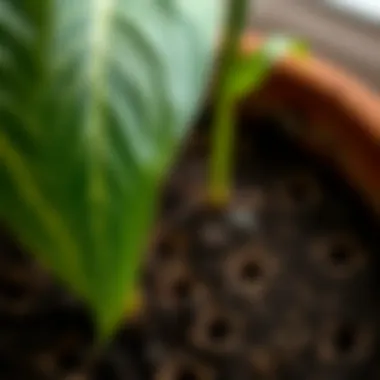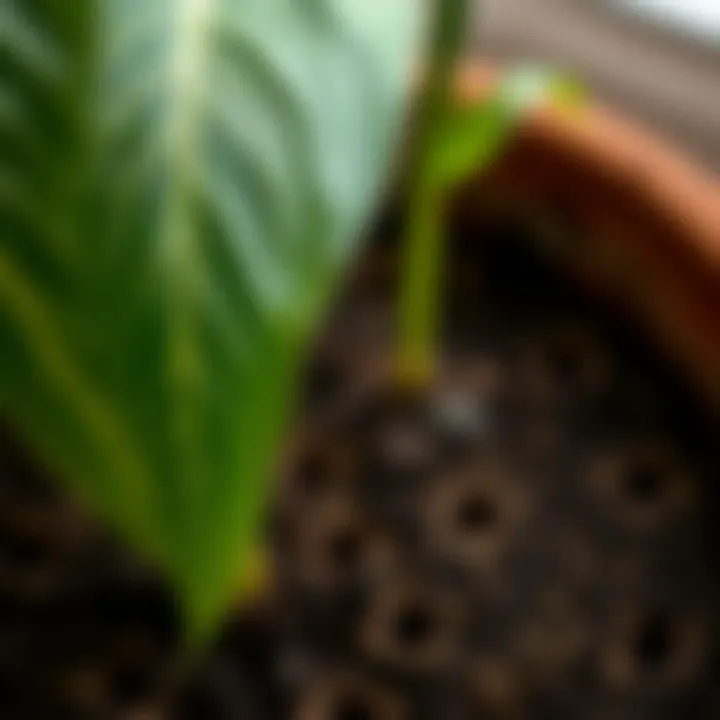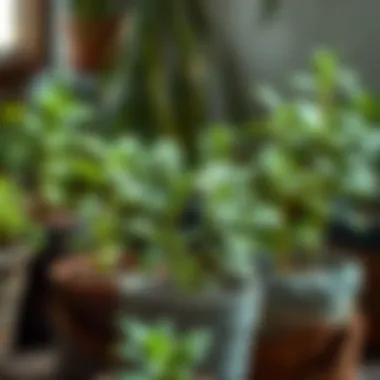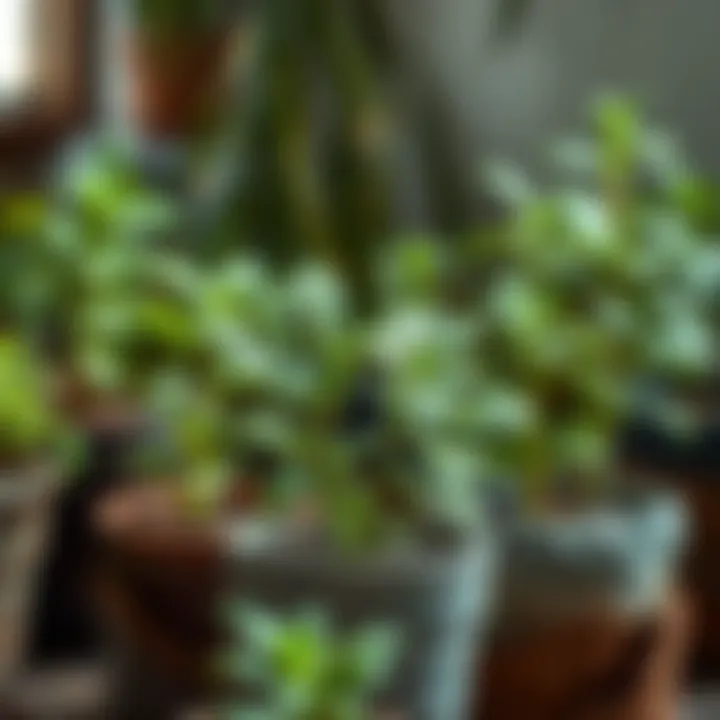Understanding Drainage's Role in Plant Pots


Intro
When it comes to plants, every petal and leaf hinges on fundamental aspects like light, soil, and most importantly, drainage. The right drainage in plant pots goes a long way in promoting plant health and growth. If you’ve ever seen a plant wilt or turn brown from overwatering, you’ll appreciate that this topic is as crucial as it is often overlooked. Without proper drainage, even the most verdant ferns can succumb to the perils of soggy roots that are quite prone to rot.
In the coming sections, we’re going to break down the nitty-gritty of drainage in plant pots. We will explore designs, materials, and the various types of drainage systems available. By the end of this article, you’ll not just learn about why drainage matters but also how to choose the right pots that can keep your plants thriving.
Let’s take a deep dive into understanding the role of drainage in maximizing plant growth.
The Necessity of Drainage in Plant Pots
When thinking about houseplants, it's easy to get caught up in the pretty leaves or vibrant flowers. Yet, there’s a behind-the-scenes hero that plays a crucial role in their survival—drainage. Understanding the vital importance of drainage in plant pots is essential for any successful gardener or homeowner looking to nurture thriving greenery. Proper drainage not only helps plants stay clear of potential hazards but also empowers their growth by ensuring that roots receive just the right amount of moisture.
Understanding Plant Roots
To fully appreciate why drainage is so necessary, one must consider what’s happening beneath the soil. Plant roots, much like our own fingers, reach out in search of nourishment and stability. They can only thrive in an environment that balances moisture and air. When a plant’s roots sit too long in standing water, they suffocate. Roots need air pockets in the soil to breathe. When soil retains too much moisture, it can create a more swamp-like environment than a thriving garden, inviting issues like disease and decay.
Plants built for survival have evolved in natural settings to have adapted root systems that respond to their environment. For instance, native species might flourish in a sandy soil that drains quickly, while others may prefer a mix that retains a bit more moisture. All plants, however, share one common necessity: they flourish best when their roots are healthy and able to function without being constantly waterlogged.
The Consequences of Poor Drainage
The ramifications of ignoring drainage are as serious as it gets. Allowing pots to hold onto excess water can result in root rot—an ailment that can quickly spell doom for your plants. Root rot, caused by fungal pathogens, turns roots from healthy and white to mushy and dark. Think about it: a plant whose roots are rotting is like a ship taking on water. It won't be long before it's sinking.
Moreover, poor drainage contributes to the formation of anaerobic conditions in the soil, which can lead to a decline in the healthy bacteria needed for plant growth. When beneficial bacteria suffer, nutrients become less accessible to the plant, impacting its overall health and resilience.
In cases where drainage is ignored or improperly managed, one might notice other subtle changes—leaves yellowing, sudden wilting, or growth stunting. Even the most passionate plant parent can't save a wilting fern that's effectively drowning in its own pot.
Finding pots that facilitate and allow proper drainage is not simply a best practice—it's a fundamental step in ensuring that the plants you choose can thrive in their chosen environment. As we explore further in this article, we'll delve into various drainage systems, materials, and designs that can make a significant difference in your gardening experience.
"Understanding the roots and their relationship with drainage can be the difference between a green thumb and a brown thumb."
In summary, recognizing the necessity of drainage in plant pots is not just a technicality; it is a vital consideration in the journey towards successful gardening. When we take root structures and drainage into account, we set our plants up for success, allowing us to enjoy a flourishing indoor oasis.
Benefits of Using Plant Pots with Drainage
In the world of gardening, the significance of using plant pots equipped with drainage cannot be overstated. Proper drainage plays a vital role in plant health, ultimately leading to vibrant growth and a flourishing environment. When selecting pots for your green companions, understanding the benefits of integrating drainage systems enables homeowners and plant enthusiasts alike to make thoughtful decisions that favor robust plant life.
Enhanced Growth and Health of Plants
A well-drained pot can make all the difference for your plants, acting as a key player in their growth and overall vitality. Plants thrive on balance, and the right amount of water is crucial. Excess water can drown roots, killing off your precious plants before they can bloom. Conversely, with effective drainage, not only does excess water escape, but it helps aerate the soil as well. Air circulation around the roots means healthier, more robust vegetation afterward.
Just picture a plant struggling in stagnant water; it's not a pretty sight.
- Roots breathe: Good drainage allows roots to absorb nutrients and oxygen effectively.
- Nutrient uptake: Healthy roots lead to better nutrient absorption, leading to lively leaves and vivid flower colors.
- Disease resistance: A dry root zone lowers the risk of fungal and root diseases, safeguarding your plants’ health.
This enhances the plant's ability to flourish, leading to a bountiful garden that beckons admiration.
Prevention of Root Rot
One of the most common woes for plant lovers is root rot—a term that sends chills down the spine of many. Root rot is caused when roots sit in waterlogged soil for too long, essentially leading them to drown and decompose. This can occur swiftly and secretly, often leaving keen gardeners at a loss once they notice the signs. Utilizing pots with drainage keeps roots from becoming over-saturated, thus preventing the dreaded rot.
To effectively guard against root rot:
- Choose the right pot: Holes at the bottom ensure water doesn’t accumulate, drastically reducing the chances of rot.
- Select appropriate soil: Well-draining soil, possibly mixed with perlite or sand, can enhance drainage.
- Monitor moisture: Regular checks allow gardeners to catch moisture issues long before they escalate.
Maintaining proper drainage gives peace of mind, ultimately allowing you to enjoy a flourishing plant without the lurking fear of root rot throttling its growth.
Regulation of Soil Moisture
Managing soil moisture is like fine-tuning a delicate instrument; it requires attention but pays off with harmonious growth. Pots that provide drainage are designed to balance moisture levels. These pots help remove excess water, ensuring that your plants receive just what they need—no more, no less. In simple terms, think of it as a backyard concert where each performer plays their part without drowning out the others.
- Consistent hydration: A drained pot prevents the soil from becoming mud, ensuring consistent hydration instead.
- Avoiding dry spells: Good drainage also helps avoid dry spots in the soil, allowing even moisture through the entire root zone.
- Tailored watering: Homeowners can adjust their watering schedules with confidence, knowing excess water won't be sitting around causing trouble.


By ensuring that soil moisture remains in check, plant pots with drainage help create an environment conducive to growth and health.
"The right plant pot not only holds the plant but also nurtures its very existence with appropriate drainage." — Gardening Enthusiast
Types of Drainage Systems in Plant Pots
The way drainage is designed in plant pots can significantly influence a plant's overall health and growth. Different drainage systems have their unique advantages and are suited for various types of plants and environments. Understanding these options allows homeowners and gardening enthusiasts to choose wisely, ensuring that their plants thrive.
Traditional Drain Holes
Traditional drain holes are perhaps the most recognized method of managing excess water in plant pots. These small openings at the bottom of the pot allow water to escape, thereby preventing water from pooling and saturating the soil. This design is straightforward yet effective, making it popular among gardeners.
Benefits of traditional drain holes include:
- Simplicity: Easy to manufacture and utilize, these pots don’t require complex designs or additional features, making them affordable.
- Versatility: They work well for a wide range of plants, from delicate succulents that require quick drying soil to larger plants that prefer more moisture.
- Ease of Monitoring: With a straightforward drainage design, monitoring the pot's moisture level becomes easier. If soil appears dry or wet, adjustments can be made accordingly.
A downside, however, is that a pot without a proper saucer may create a mess, leading to water stains or soil spillage. But with a bit of care in placement, traditional drain holes are a solid choice for plant care.
Self-Watering Pots
Self-watering pots are a modern innovation that cater to busy plant lovers. These pots feature two chambers: one for soil and one for water. Water is absorbed through a wick or porous material, supplying plants with moisture as needed. The system can be particularly useful for those who travel frequently or have a hectic schedule, ensuring that plants remain hydrated without constant intervention.
Some highlights of self-watering pots:
- Consistent Moisture Levels: These pots minimize the risk of over or under-watering by supplying plants with a steady amount of moisture.
- Ideal for Beginners: For those who may not have much experience in plant care, self-watering pots simplify the watering process, providing a cushion against mistakes that could lead to root rot or other issues.
- Water Conservation: The water reservoir encourages more efficient use of water, which can be a boon for environmentally conscious gardeners.
"Self-watering pots can take the guesswork out of plant care, offering a steady supply of moisture while giving the user peace of mind."
Bonneted Drainage Systems
Bonneted drainage systems present an alternative approach by adding layers of effective drainage features. These pots incorporate a series of strategically placed holes and channels that help direct excess water away from the roots while ensuring that moisture is still available.
The advantages of bonneted systems include:
- Enhanced Aeration: By allowing air to circulate more freely around the root zone, these pots can promote stronger root development and nutrient absorption.
- Reduction of Silt Build-Up: The structured drainage design mitigates the potential for soil particles clogging traditional holes, which can be especially helpful for finer soils.
- Versatile Water Management: They can handle various types of plants, offering flexibility for indoor and outdoor use.
However, it is essential for users to be mindful of how much water is in the reservoir, as this system can retain moisture more than basic designs, thereby influencing how often a gardener waters.
Selecting the Right Pot Size
Choosing the right pot size for your plants is a crucial decision that carries weighty implications for their health and growth. When determining the size of a pot, several factors come into play, including the type of plant, its root system, and the overall aesthetic you wish to achieve in your space. A mismatched pot can hinder growth, lead to poor drainage, and even contribute to plant death.
When opting for a pot, don’t just consider how it looks on your window sill or tabletop; instead, think of it as creating the perfect home for your greenery. A well-fitted pot helps keep soil moisture at the right levels, capitalizes on nutrients, and supports strong root development.
"A pot that’s too small stifles roots, while one that is too large can drown your plant."
Matching Pot Size to Plant Size
To ensure your plants thrive, the first step is to match the pot size to the plant size. Each type of plant has its own spatial requirements based on its root system and overall growth habit. For example, a majestic peace lily needs a snug home that gives its roots just enough room to stretch but not enough to feel overwhelmed. In contrast, a larger rubber tree will thrive in a pot that allows for ample space as it grows.
Here’s a way to gauge which size is fitting:
- Small Pots (under 4 inches): Best for seedlings or succulents. They keep moisture contained but can dry out quickly.
- Medium Pots (4 to 10 inches): Good for moderate-sized plants like ferns or dwarf varieties.
- Large Pots (over 10 inches): Ideal for larger, robust plants needing stability and space, such as snake plants or fiddle leaf figs.
If you’re not sure, it’s wise to choose pots that have a slightly larger diameter than the plant’s root ball. This approach allows for growth without allowing the soil to become boggy.
Adjustments for Growth
As plants mature, their requirements can shift dramatically. An initial choice in pot size that seemed ideal can quickly become inadequate as roots outgrow their home. Regularly assessing the plant's growth and adjusting pot sizes accordingly is key.
When considering pot adjustments, consider these steps:


- Monitor Root Visibility: If roots start to peek through drainage holes or the top of the soil, it's high time for an upgrade.
- Transplanting: Moving to a larger pot allows for better soil aeration and drainage, which can lead to healthier growth.
- Soil Refresh: When transferring to a larger pot, it’s also a good opportunity to refresh the soil, replacing old nutrients with fresh ones.
In the world of plant care, observation stands as an invaluable tool. By staying attuned to the needs of your greenery, you can navigate the complexities of pot sizing with relative ease. Remember, the ultimate goal is to create a thriving ecosystem that supports growth while showcasing the beauty of your plants.
Materials for Plant Pots
When it comes to choosing plant pots, the materials used make a world of difference. Each material brings its own set of properties that can influence a plant's growth, moisture retention, and overall health. Understanding these materials is essential, especially for homeowners and gardening enthusiasts aiming to set their plants up for success. Different materials offer unique benefits and potential drawbacks which can affect the drainage capacity, insulation properties, and aesthetic appeal of the pots.
Terracotta and Ceramic
Terracotta pots are a popular choice among gardeners due to their rustic charm and excellent breathability. The porous nature of terracotta allows for air exchange through the walls of the pot, preventing water from becoming stagnant. This feature is crucial for root health, as plants thrive with a balance of moisture and air.
Ceramic pots, often clad in glazes, can also provide a stylish alternative. While they maintain the benefits of breathability, glazed finishes create a waterproof barrier. This means that while they might hold moisture, proper drainage systems remain necessary to prevent root rot. Eager green thumbs might find terracotta or ceramic pots appealing for their aesthetic, but they also need to be conscious of how drainage holes can contribute to healthy soil moisture levels.
"A pot isn't just a container; it's a happy home for your plants."
Plastic and Resin
In contrast to natural materials, plastic and resin pots offer a lightweight and often more affordable option for plant enthusiasts. What sets these materials apart is their strong resistance to moisture and extreme temperatures. While plastic pots can sometimes lack effective breathability, many modern plastic pot designs now feature built-in drainage systems that help manage excess water.
Resin pots mimic the look of natural materials while giving you the lightweight benefits of plastic. They often include various colors and styles, making them suitable for more modern or trendy home designs. Homeowners looking for cost-effective solutions might find that plastic or resin pots suit their needs, as they tend to retain heat more effectively during cooler months, promoting early growth in plants.
Metal and Other Materials
Potting choices aren’t limited to traditional pottery and plastics. Metal pots, often made of galvanized steel or aluminum, provide a durable and stylish look. However, metal pots can retain heat more than other materials, which can lead to oversaturation of moisture if not carefully monitored. An advantage is that they typically resist pests better than organic materials, making them a good option for outdoor use.
Other materials, like reclaimed wood or biodegradable pots, present unique avenues for plant potting as well. Wood pots, while charming, often require liners to mitigate the risks of rot and degradation. Biodegradable materials are gaining popularity for their eco-friendliness, yet homeowners should ensure they meet the needs of the specific plants being grown.
Innovations in Pot Design
The world of gardening, particularly when it comes to pot design, stands at a fascinating crossroads where functionality meets creativity. Innovations in drainage solutions are a key focal point, reflecting a growing understanding of plant needs coupled with insights into sustainable practices. As homeowners and plant enthusiasts seek ways to nurture their green companions, advanced pot designs come to the forefront, promising not only healthier plants but also meaningful contributions to the environment.
Technological Advances in Hydroponics
Hydroponics has gained momentum, reshaping how plants are nurtured with limited soil. This method employs a nutrient-rich water solution, eliminating the need for traditional soil cultivation. As hydroponic systems evolve, so do the designs of the pots used. Closed-loop systems reduce water waste and enhance plant health by maintaining optimal moisture levels without the risk of root rot.
Advances such as automated nutrient delivery systems allow clever adaptation of pot designs to cater to specific plant types. For example, modular pots that can be connected offer gardeners the ability to customize nutrient delivery per plant's growth stage. This not only maximizes yield but ensures that each plant receives tailored care.
- Key Benefits of Technological Advances:
- Efficient use of water resources.
- Tailored care for plant needs.
- Enhanced plant growth speed and yield.
- Reduction of labor-intensive care.
Maintaining Pots with Drainage
When it comes to keeping your plants happy and flourishing, maintaining pots with drainage is a key area that shouldn't be overlooked. These pots offer functionality that goes beyond mere aesthetics; they play a pivotal role in ensuring the well-being of your plants. Good maintenance not only helps in promoting healthy growth but also extends the life of your pots.
Regular Care and Cleaning
Just like with any other household item, pots benefit greatly from regular care and cleaning. Dirty pots can become a breeding ground for harmful bacteria and pests, which can eventually affect the health of your plants.
- Remove Debris: Every so often, it’s wise to clear out any dead leaves, old soil, or even mold that might be accumulating. A quick inspection can go a long way in preventing bigger problems down the line.
- Washing Pots: When cleaning your pots, simple soap and water often do the trick. For stubborn stains or residue, consider a baking soda solution that is both safe for the plants and effective for cleaning.
- Inspect Drainage Holes: Don’t forget to check the drainage holes. They should remain unblocked to allow excess water to escape. Clogged holes can lead to water retention, ultimately causing root rot and other issues. Using a chopstick or similar tool can help to clear any blockage without damaging the pot.
Observing Soil Moisture Levels
Keeping tabs on soil moisture is another essential part of maintaining pots with drainage. Understanding when to water your plants can make all the difference.
- Moisture Meter: Utilizing a moisture meter can give you accurate readings, indicating whether the soil is too dry or overly saturated. This simple tool helps you avoid the either scenario where your plant trails towards dehydration or drowns in excess water.
- Touch Test: If a meter isn't available, a basic touch test can be effective, too. Simply stick your finger about an inch into the soil. If it feels dry to the touch, it’s about time to give your plant some water. If it feels damp or wet, leave it alone for a bit.
- Signs to Watch For: Pay attention to your plants. Yellowing leaves may indicate overwatering, while drooping leaves can signify the opposite. Keeping a watchful eye will guide you in providing the best care possible.
"A keen gardener observes as much as he nurtures; for every leaf fallen or soil dried, there’s a story waiting to be told."
With consistent care and attentive observation of soil moisture levels, maintaining pots with drainage becomes less of a chore and more of an enriching experience. This approach doesn’t just enhance the health of your plants, but also fosters a deeper connection between you and your botanical companions.


Integrating Pots into Home Decor
Integrating pots into home decor goes beyond just functionality; it bridges the gap between the natural world and domestic spaces. Homes today are increasingly becoming sanctuaries that reflect personal style, and plants play a pivotal role in this environment. With the right drainage, pots become not only homes for plants but also aesthetically appealing features that uplift the overall decor.
Choosing Aesthetic Designs
When selecting pots, aesthetics demand careful consideration. The design of a pot can significantly influence how it complements the rest of the space. Here are some factors to keep in mind:
- Color Palette: The colors of the pots should harmonize with the interiors. Neutral tones like beige or gray can bring a modern touch. In contrast, bright-colored pots can add vibrancy to a muted room.
- Shape and Style: From classic round shapes to intricate geometric designs, the shape plays a role in how a pot fits within a decor scheme. A suspended planter might suit a bohemian style, while sleek ceramic pots can enhance a minimalist look.
- Textures and Finishes: Textured pots can add depth to a decor. Materials like terracotta bring an earthy vibe, while smooth ceramic or even glossy metal can introduce a modern flair.
Ultimately, aesthetic design embodies more than just visual appeal; it reflects personal taste and enhances the ambiance of the home. Investing in decorative elements that marry both function and style is a key takeaway.
Placement Considerations
The placement of pots within your home can greatly influence their impact. Here are some considerations to ensure your plant pots thrive while being beautifully showcased:
- Natural Light: Consider areas where your plants can receive adequate light. Placing pots near windows or in bright corners encourages healthy growth and adds vibrancy to those spaces.
- Focal Points: Use pots as focal points in rooms. Large, unique pots can anchor a seating area or serve as a statement piece in an entryway.
- Variety of Heights: Mixing different pot heights can create visual interest. For example, placing taller pots next to shorter ones can form a dynamic arrangement that draws the eye.
- Functionality vs. Aesthetics: Balance aesthetics with practicality. Ensure that pots are positioned where they can be easily accessed for watering and care, but also think of how they flow with the space.
Placing pots thoughtfully can transform an ordinary room into a lively and welcoming environment.
"Whether minimalistic or lush with foliage, the integration of pots into home decor invites nature indoors, enriching spaces and improving well-being."
In essence, integrating pots into home decor not only beautifies a setting but also establishes a connection with the outdoors, promoting a sense of peace and serenity within the home.
Environmental Impact of Pot Materials
The materials used in plant pot manufacturing play a crucial role not only in the life of your plants but also in our environment. The growing concern for sustainability means that both homeowners and gardeners are keen to understand the environmental footprint of the materials they choose. Each type of pot material has its benefits and drawbacks, which can significantly affect one's gardening choices and ecological impact.
Sustainability in Material Selection
When it comes to selecting materials for potting, sustainability should definitely be at the forefront. Natural materials such as terracotta and ceramic are often favored because they are biodegradable. However, their production involves mining clay and other resources, which can have negative effects on ecosystems.
On the other hand, plastic pots, while lightweight and inexpensive, pose a different challenge. They are created from petroleum-based products which can take centuries to decompose. Plus, they often end up in landfills, contributing to pollution. Instead of choosing pots based solely on price and appearance, consider their life cycle and environmental impact.
Here are some sustainable options:
- Terracotta: Naturally porous, it allows for better air circulation and moisture retention. Check for local clay sources to minimize transport emissions.
- Recycled Plastic: These pots reuse waste material, lessening the strain on landfills. It’s a practical choice for those who want to garden without creating more waste.
- Biodegradable Composites: These new-age materials often combine natural fibers with compostable plastics.
Making informed selections about pot materials isn’t just about aesthetics. It’s about considering the entire ecosystem.
Recycling Options for Plant Pots
Recycling pots can profoundly lessen environmental strain. Many homeowners aren’t aware that their used pots can have a second life instead of ending up in a garbage dump. Understanding the recycling options available can lead to a more sustainable gardening practice.
Many local nurseries and gardening centers promote pot recycling. Here’s what you can do with those old pots:
- Check for Local Programs: Some communities have programs that recycle pots, especially plastic ones.
- Upcycling: Get creative! Use old pots as decorative elements in the garden, planters for herbs, or even homemade bird feeders.
- Composting: Some biodegradable pots can go directly into a compost heap without any concerns.
"Choosing the right pot not only nurtures your plants but also safeguards our planet's future."
By understanding the environmental impact of pot materials and opting for sustainable solutions, we contribute to a greener planet while providing a healthy home for our plants. A little mindfulness in material selection can go a long way in minimizing our ecological footprint and promoting a balanced relationship with nature.
Closure
The importance of drainage in plant pots cannot be overstated. As we've explored throughout this article, proper drainage plays a vital role in the health and development of plants, a factor that every gardener, interior designer, and homeowner should take to heart. Not only does effective drainage prevent water from pooling in the pot, which can be detrimental to plant roots, it also allows for the regulation of soil moisture levels. This regulation is crucial for maintaining an environment conducive to growth.
Summarizing Key Insights
To sum up, several key points emerge regarding drainage:
- Understanding Plant Needs: Different plants have varied water requirements. Some thrive in moist conditions while others need drier soil. A pot with adequate drainage accommodates these needs more effectively.
- Preventive Measure Against Root Rot: Poor drainage can lead to root rot, a common issue that many plant owners face. By opting for pots designed with proper drainage, you can significantly reduce the risk.
- Soil Health Maintenance: Healthy soil leads to healthy plants. Allowing excess water to escape helps preserve the soil's structure and balance, promoting better aeration and nutrient availability.
From these insights, it's clear that drainage isn't just an optional feature; it's an essential component of effective potting.
Future Trends in Plant Pot Design
As we look ahead, the future of plant pot design seems promising, particularly with innovations aimed at enhancing plant health and urban gardening practices. We can anticipate:
- Integration of Smart Technology: The incorporation of sensors to monitor soil moisture can provide real-time feedback, allowing gardeners to optimize their watering routines.
- Sustainable Materials: A shift toward eco-friendly materials in pot construction is gaining traction. Biodegradable options may become more commonplace, appealing to environmentally-conscious consumers.
- Hybrid Designs: We might see a rise in pots that combine traditional drainage systems with self-watering features, offering the best of both worlds. These designs seek to cater to those wishing for low-maintenance gardening solutions.















